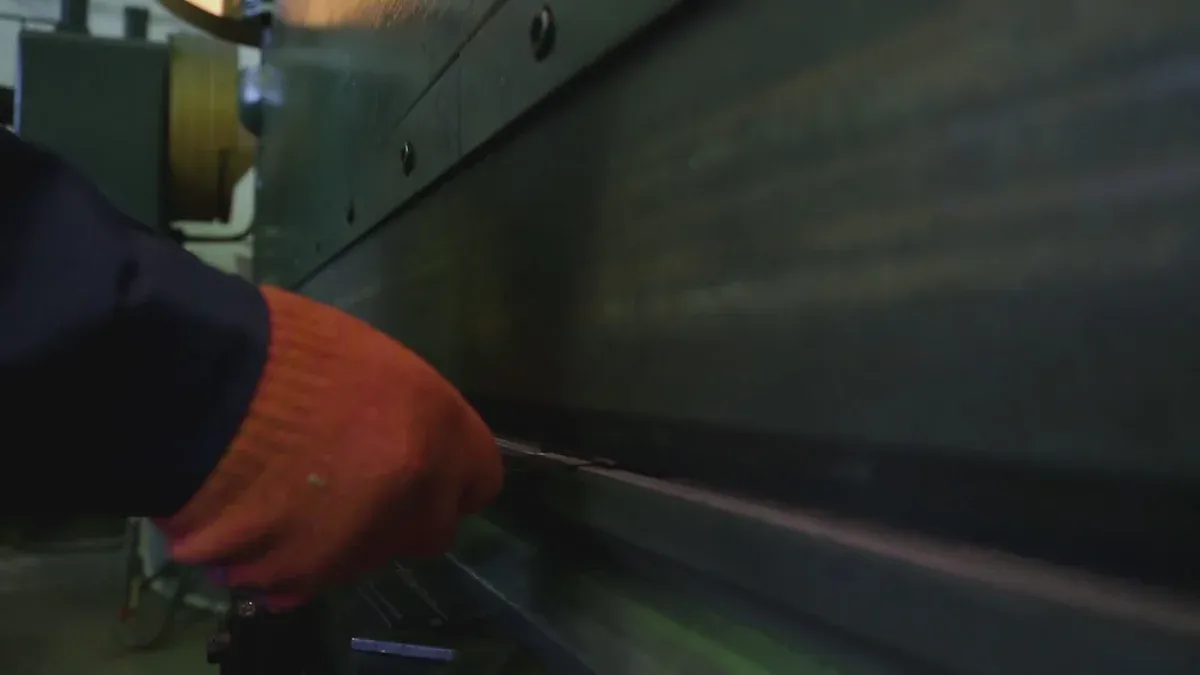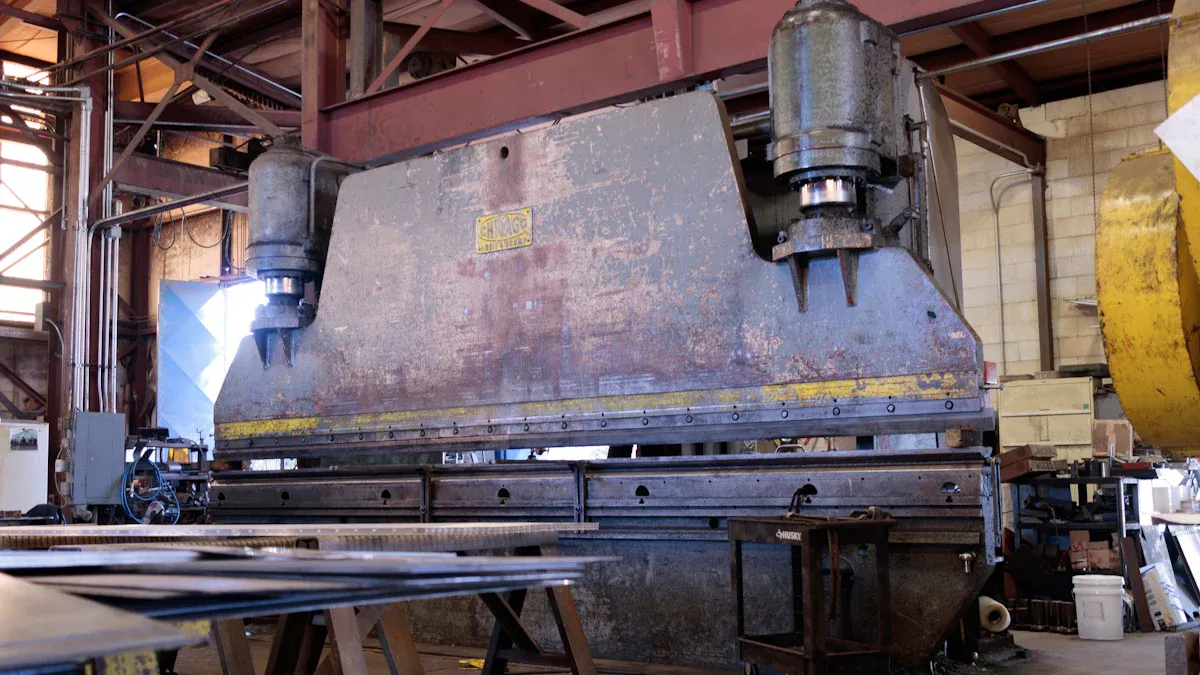How to Calculate Bending Tonnage for Press Brakes
Table of Content
Press Brake Tonnage Calculator
Accurate bending tonnage calculation helps operators select the right press brake power for each job. This process improves production efficiency and protects equipment from damage. Operators consider material properties, bend angle, and bend length to avoid failed bends.
- Proper tonnage selection ensures machines complete operations without issues.
- Efficient calculations optimize material use and reduce waste.
- Thicker and stronger materials require more tonnage, while longer bends and sharper angles need additional force.
Key Takeaways
- Accurate bending tonnage calculation is crucial for selecting the right press brake power, improving production efficiency, and preventing equipment damage.
- Operators should always gather essential data, including material properties and tooling dimensions, to ensure correct tonnage calculations.
- Using online calculators and tonnage charts can speed up the calculation process and help avoid manual errors.
- Material type significantly affects the required tonnage; always check tensile strength before starting calculations.
- Adding a safety margin to tonnage calculations protects equipment and accounts for variables like material inconsistencies.
Bending Tonnage Calculation Formula

Standard Formula Overview
Operators use several formulas to estimate press brake tonnage. The most common formula for bending force is:
| Formula | Description |
|---|---|
| F = (1.42 × TS × S² × L) / 1000 | Main formula for calculating bending force |
| P = 650 × S² × L / V | Bending force in kilonewtons (kN) based on thickness, bend length, and die opening width |
| R = (5 × V) / 32 | Internal radius calculation |
In these formulas:
- F or P represents the bending force or press brake tonnage required.
- TS stands for tensile strength of the material.
- S is the material thickness.
- L is the length of the bend.
- V is the die opening width.
Operators often refer to tonnage charts for quick estimation. These charts list recommended press brake tonnage values for different materials and thicknesses. Many professionals also use online calculators to simplify the process.
Tip: Online calculators and tonnage charts help operators avoid manual errors and speed up bending tonnage calculation.
Sinking Press Brake Tonnage Formula
Sinking, or bottom bending, requires a different approach. The formula for forming tonnage is more detailed:
| Formula | Description |
|---|---|
| Forming tonnage = {[575 × (material thickness squared)] / die-opening width / 12} × length of bend × material factor × method factor × multiple-bend tooling factor | Calculates forming tonnage for bottom bending |
Operators must adjust the method factor based on the bending technique:
| Factor | Description |
|---|---|
| Material factor | Material tensile strength in PSI / 60,000 |
| Method factor | 5.0+ for bottom bending, 10.0+ for coining, 1.0 for air bending |
Bottom bending and coining require higher press brake tonnage than air bending. The method factor reflects this difference.
Material and Die Variables
Material properties and die selection play a major role in press brake tonnage. The tensile strength of the material determines the force needed for bending. Materials with higher tensile strength require greater bending force. Operators use the tensile strength to convert tonnage charts for different metals.
Die opening size also affects the calculation. A wider die opening generally requires less force to achieve the bend. The Rule of Eight helps operators select the right die: the die opening should be eight times the thickness of the material. This principle ensures proper bending and reduces the risk of tool damage.
| Parameter | Value |
|---|---|
| Thickness of steel | 0.5 inches |
| Length of bend | 10 inches |
| V-die width | 4 inches |
| Material Factor (MF) | 15 |
| Bend Force | 9.375 tons |
For example, when bending mild steel with a thickness of 0.5 inches, a bend length of 10 inches, and a die opening of 4 inches, the required press brake tonnage is 9.375 tons. Operators must adjust these values for different materials and die openings.
Note: Always check the material’s tensile strength and select the die opening according to the Rule of Eight for accurate tonnage calculation.
Press Brake Tonnage Factors
Material Type
Material type plays a major role in bending force requirements. Each metal has a unique tensile strength, which determines how much force the press brake must apply. For example, aluminum bends more easily than stainless steel. Operators often compare materials using a ratio based on mild steel. Aluminum requires only about 55% of the tonnage needed for mild steel, while stainless steel demands 1.5 times more force. The table below shows how different materials affect press brake tonnage:
| Material Type | Tensile Strength (MPa) | Tonnage Requirement Ratio |
|---|---|---|
| Aluminum | ~210 | 0.55 times mild steel |
| Mild Steel | ~370 | 1.0 |
| Stainless Steel | ~620 | 1.5 times mild steel |
Operators should always check the material’s tensile strength before starting a bending tonnage calculation.
Thickness and Bend Length
Material thickness and type directly impact the bending force needed. Thicker sheets require more force, and the length of bend also increases the required tonnage. For instance, bending a 2mm sheet with a 12mm die opening needs about 23 tons per meter. A 10mm plate with a 100mm die opening requires 59 tons per meter. Longer bends, such as a 4-foot piece, need more force than shorter ones. Bending 4 feet of 3/8″ mild steel may require 100 tons on a 3″ die, while 1/4″ mild steel needs 15 tons per foot on a 2″ die opening. Operators should reference tonnage charts for different material thickness and bend lengths to ensure accurate press brake tonnage.
Die Opening and Tooling
Die opening size affects the bending force calculation. A larger die opening reduces the force needed, while a smaller opening increases it. For materials up to 3mm thick, operators select a die opening 6-8 times the thickness. For thicker materials, the die opening should be 10-12 times the thickness. Proper tooling selection helps prevent tool damage and ensures consistent bends. Operators should consult tonnage charts that match die opening sizes with material thickness for reliable results.
Bending Method
The bending method changes the amount of force required. Air bending uses less force than bottom bending or imprinting. Bottom bending needs more press brake tonnage because the material contacts the die along its entire length. Imprinting requires the highest force. The table below compares common bending methods:
| Bending Method | Tonnage Requirement |
|---|---|
| Air bending | Requires less tonnage |
| Bottom bending | Requires more tonnage |
| Imprinting | Requires the highest tonnage |
Operators should select the bending method based on the job’s requirements and always adjust the bending tonnage calculation accordingly.
Tip: Tonnage charts and online calculators help operators match material type, thickness, die opening, and bending method for accurate bending force estimates.
Calculate Press Brake Tonnage: Steps

Data Collection
Operators must gather essential information before they calculate press brake tonnage. Collecting accurate data ensures the correct tonnage for each bending operation. The following checklist helps organize the process:
- Material properties, such as tensile strength and thickness
- Tooling dimensions, including die width and punch radius
- Ratios that influence bending, like die ratio and K factor
To begin, operators should:
- Input the material type and thickness.
- Specify die and punch parameters.
- Provide the overall bending length.
Accurate data collection forms the foundation for a reliable tonnage calculation. Operators who measure material thickness precisely and record tooling details avoid costly mistakes. Understanding material factors is crucial because each metal has unique strength and bending characteristics.
Tip: Always verify material specifications and tooling dimensions before starting the calculation. This step prevents errors and ensures the correct tonnage for the job.
Applying the Formula
After collecting the necessary data, operators apply the formula to calculate press brake tonnage. The standard formula for air bending is:
Tonnage = (575 × (material thickness^2) / (die-opening width / 12)) × bend length × material factor × method factor × tooling factor
Operators follow these steps:
- Measure the material thickness accurately.
- Use the formula above to calculate the required tonnage.
- Adjust for material type, since different metals need different force.
For example, consider air bending a mild steel sheet with a thickness of 0.25 inches, a bend length of 36 inches, and a die opening of 2 inches. The material factor for mild steel is 1.0, and the method factor for air bending is 1.0. The calculation looks like this:
Tonnage = (575 × (0.25^2) / (2 / 12)) × 36 × 1.0 × 1.0 × 1.0
Tonnage = (575 × 0.0625 / 0.1667) × 36
Tonnage = (35.9375 / 0.1667) × 36
Tonnage = 215.63 × 36
Tonnage ≈ 7,762.68 lbs (or about 3.88 tons)
This result shows the correct tonnage for air bending this specific sheet. Operators must adjust the formula for other materials by changing the material factor.
Note: Operators should always use the correct tonnage for each material and bending method. This practice protects equipment and ensures quality bends.
Using Calculators and Charts
Online calculators and tonnage charts simplify the process for operators who need quick estimates. These tools require key variables, such as material type, thickness, and bend length. Operators enter the data, and the calculator provides an estimated tonnage.
Best practices for using calculators and charts include:
- Use online calculators for fast estimates by entering material type and thickness.
- Treat calculator results as starting points, especially for materials other than mild steel.
- Match material characteristics with tonnage chart specifications for accurate results.
- Consider bend specifications, such as angle and length, when using tonnage charts.
Operators should always compare calculator results with tonnage charts to confirm accuracy. Charts display recommended tonnage values for different materials, thicknesses, and die openings. Matching the job’s specifications with chart data helps operators select the correct tonnage.
💡 Tip: Use calculators and charts together for the most reliable results. Double-check all inputs and compare with manufacturer guidelines to ensure the correct tonnage.
Safety and Practical Tips
Avoiding Mistakes
Operators can avoid costly errors by following best practices during press brake tonnage calculation. Common mistakes include:
- Using nominal instead of actual material thickness, which leads to inaccurate bending force estimates.
- Ignoring material grain direction, which can change the required bending force by 5–15%.
- Overlooking die wear or using mismatched units, such as mixing metric and imperial measurements.
- Neglecting springback, which results in under-bending and poor part quality.
- Skipping safety margins, which increases the risk of equipment damage or injuries.
Operators who double-check these factors achieve the correct tonnage and maintain consistent results.
Safety Precautions
Safe operation of a press brake requires strict attention to safety protocols. The table below outlines essential safety precautions:
| Safety Precaution | Description |
|---|---|
| Wear Personal Protective Equipment (PPE) | Use safety glasses, gloves, steel-toed boots, and hearing protection to prevent injuries. |
| Get the Right Training | Ensure operators receive comprehensive training on safety procedures and emergency shutdown techniques. |
| Examine Equipment | Inspect for wear, damage, or failure before use; report any issues to a supervisor. |
| Safe Workspace | Keep the area around the machine clear of obstacles and ensure proper ventilation and lighting. |
| Use Machine Guards | Ensure all machine guards are secured and functioning to protect users from moving parts. |
| Handle Materials Safely | Use proper lifting techniques and tools to avoid injuries when handling materials. |
| Observe Procedures | Follow specified operating rules and safety standards to ensure safe operation. |
| Prevent Reach-in Hazards | Keep hands and clothing away from moving parts to avoid pinch or entanglement injuries. |
| Stay Alert | Remain focused and avoid distractions during operation to prevent accidents. |
Mechanical guards, emergency stop buttons, and two-handed controls further reduce the risk of accidents. Operators who follow these guidelines protect themselves and others while maintaining the correct tonnage for each job.
Manufacturer Guidelines
Manufacturers provide clear instructions to help operators achieve accurate press brake tonnage and safe operation. Operators should:
- Verify material properties, such as tensile strength, to match the values used in the tonnage calculation.
- Consult the press brake and tooling manufacturer’s guidelines for any specific adjustments or considerations.
- Use the correct tonnage factor for each bending method: 1.0+ for air bending, 5.0+ for bottom bending, and 10.0+ for coining.
Operators must never exceed the machine’s bending capacity. Using tooling or applying bending force beyond the rated limit can cause equipment failure and create serious safety hazards. Regular calibration also supports safe operation. Heavy usage requires calibration every 3 to 6 months, while occasional or light usage may only need checks every 6 to 12 months.
⚠️ Always operate within the recommended limits to extend machine life and ensure safe, accurate bends.
Accurate press brake tonnage calculation depends on following essential steps:
- Gather data for material type, thickness, bend length, and V-die opening.
- Apply the base formula and adjust for material.
- Convert units and add a safety margin.
- Verify results with software or test bends.
- Cross-check with charts and confirm parameters.
Operators must consider every factor, including forming method and tooling, to achieve the correct tonnage. Neglecting details can cause serious issues during bending. Using calculators and charts improves accuracy, while manufacturer guidelines help prevent mistakes and protect equipment. By following these practices, operators ensure the correct tonnage for safe and efficient metal fabrication.
*Using precision tools and calculation software simplifies the process and supports reliable results. Adhering to manufacturer recommendations also reduces risk and improves quality.*
FAQ
What is the Rule of Eight in press brake bending?
The Rule of Eight states that the die opening should be eight times the material thickness. This guideline helps operators select the correct die for safe and accurate bends.
How does material type affect required tonnage?
Material type changes the force needed for bending. For example, aluminum needs less force than stainless steel. Operators must check tensile strength before calculating tonnage.
Can online calculators replace manual tonnage calculations?
Online calculators provide quick estimates. Operators should use them as a starting point and always verify results with charts and manufacturer guidelines.
Why is it important to add a safety margin to tonnage calculations?
A safety margin protects equipment and operators. It accounts for variables like material inconsistencies and tool wear. Operators reduce risk by including a safety margin.
What happens if the press brake tonnage exceeds machine capacity?
Exceeding machine capacity can damage equipment and cause safety hazards. Operators must always check the rated limit and follow manufacturer recommendations.
